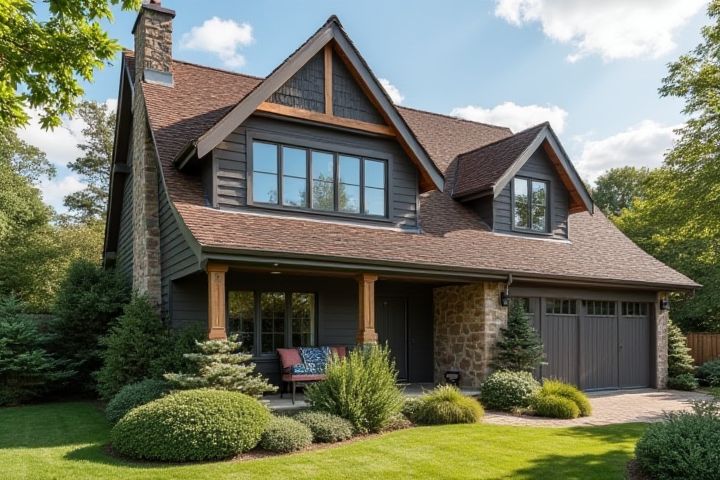
Determining the best house style for you involves evaluating personal preferences, lifestyle needs, and aesthetic tastes. Modern styles emphasize clean lines, open spaces, and minimalist decor, appealing to those who appreciate simplicity and functionality. In contrast, traditional styles often feature classic architectural details, warm colors, and ornate designs, suiting individuals who value heritage and charm. If you enjoy a blend of both, consider a transitional style that combines contemporary elements with traditional details, creating a harmonious living environment. Take into account your surroundings and the architectural styles prevalent in your neighborhood to ensure your home complements its setting.
What House Style Suits Me Best
Architectural Style Preferences
Your architectural style preferences can significantly influence your home's aesthetic and functionality. If you appreciate clean lines and minimalist design, a modern or contemporary house style may suit you best, characterized by open floor plans and large windows. Conversely, if you favor warmth and cozy charm, a traditional style featuring brick or wood siding and classic architectural details could be ideal. For a blend of both worlds, consider a transitional style that incorporates elements from both modern and traditional aesthetics, offering versatility to meet your unique tastes.
Climate Suitability
Considering climate suitability, your ideal house style may depend on local weather patterns, average temperatures, and rainfall. In warm, dry climates, a Southwestern or Adobe style with thick walls and flat roofs can help regulate indoor temperatures, while promoting energy efficiency. Alternatively, in colder, snowy regions, a Gothic or Craftsman style with steeply pitched roofs and ample insulation can prevent snow accumulation and reduce heating costs. You might also explore eco-friendly designs, such as modern sustainable homes that utilize solar panels or green roofs to adapt to your specific climate needs.
Family Needs
When considering a house style that best suits your family's needs, a spacious open floor plan is ideal for fostering communication and togetherness. A two-story home often provides separate areas for relaxation and play, accommodating both parents and children. Families with young kids may prefer a single-story layout for safety and accessibility, while featuring at least three bedrooms allows for personalized spaces for each child. Incorporating a backyard area or nearby parks enhances outdoor play opportunities, promoting a healthy, active lifestyle for your entire family.
Budget Constraints
When considering a house style that aligns with budget constraints, affordable designs like modern ranch or minimalist homes are excellent options. These styles typically feature open floor plans, which reduce construction costs and maximize usable space while ensuring energy efficiency. Opting for materials such as vinyl siding or composite roofing can further enhance affordability without compromising aesthetics. By prioritizing versatility and simplicity in design, you can create a comfortable living environment that remains financially viable.
Maintenance Requirements
When considering house styles, the maintenance requirements can greatly influence your choice. For example, a modern minimalist home often features materials like metal and concrete, requiring minimal upkeep due to their durability and resistance to weather elements. Conversely, traditional styles like Victorian may demand more frequent maintenance, including painting and repairing intricate woodwork and roof features. If you prefer lower maintenance, you might opt for a bungalow or contemporary style that promotes simple lines and efficient materials, allowing you to spend more time enjoying your home rather than maintaining it.
Future Resale Value
When considering a house style that enhances future resale value, modern designs such as contemporary or Craftsman often prove advantageous. These styles typically appeal to a broader demographic, with their open-concept layouts and energy-efficient features. Homes with classic aesthetics, like Colonial or Mediterranean, retain value due to their timeless appeal and strong architectural heritage. Invest in features such as quality materials and natural light, which can increase your home's marketability and attract potential buyers.
Lifestyle Compatibility
Consider your daily routine and personal interests when selecting a house style that aligns with your lifestyle. If you enjoy entertaining, an open-concept layout prevalent in modern designs may suit you best, allowing for seamless flow between living areas. For those who cherish tranquility and privacy, a traditional home with defined spaces and cozy nooks can create a comforting environment. Living in a home that matches your lifestyle not only enhances your well-being but can also increase the property's value, with modern designs seeing an average appreciation of up to 3% annually.
Local Building Codes
When selecting a house style that suits you best, consider the local building codes, which often dictate architectural features, materials, and structural integrity. For instance, areas prone to hurricanes may require homes with stilt foundations and aerodynamic roofs, while regions with heavy snowfall might benefit from steeply pitched roofs to prevent snow accumulation. Often, local regulations emphasize energy efficiency, potentially influencing the use of sustainable materials and technology in your design. Familiarizing yourself with these codes will not only ensure compliance but also enhance the longevity and functionality of your home.
Neighborhood Aesthetics
To choose a house style that complements your neighborhood's aesthetics, consider the architectural trends prevalent in your area. For instance, if your neighborhood features Craftsman homes, a bungalow style with exposed rafters and natural materials will blend seamlessly. Alternatively, if your community leans towards modern minimalism, sleek lines and large windows in a contemporary design might fit best. Researching local landmarks and homes can provide inspiration, ensuring your new residence harmonizes with its surroundings while reflecting your personal taste.
Space Utilization
When considering house styles that prioritize space utilization, a modern minimalist design often stands out. This style features an open floor plan, maximizing square footage and allowing natural light to flow freely, which can make even smaller areas feel expansive. Built-in storage solutions, such as wall-mounted shelves and multifunctional furniture, enhance practicality without sacrificing aesthetic appeal. You might find that a compact, efficiently designed space aligns perfectly with your desire for functionality and comfort.
